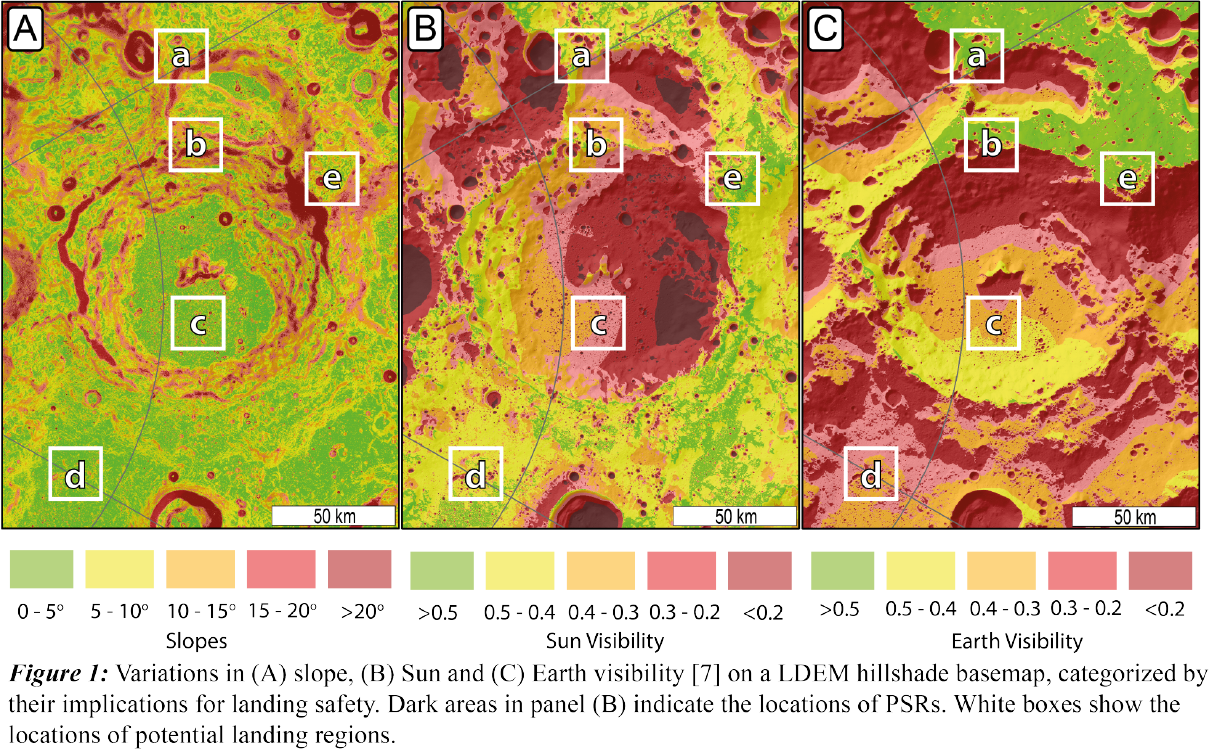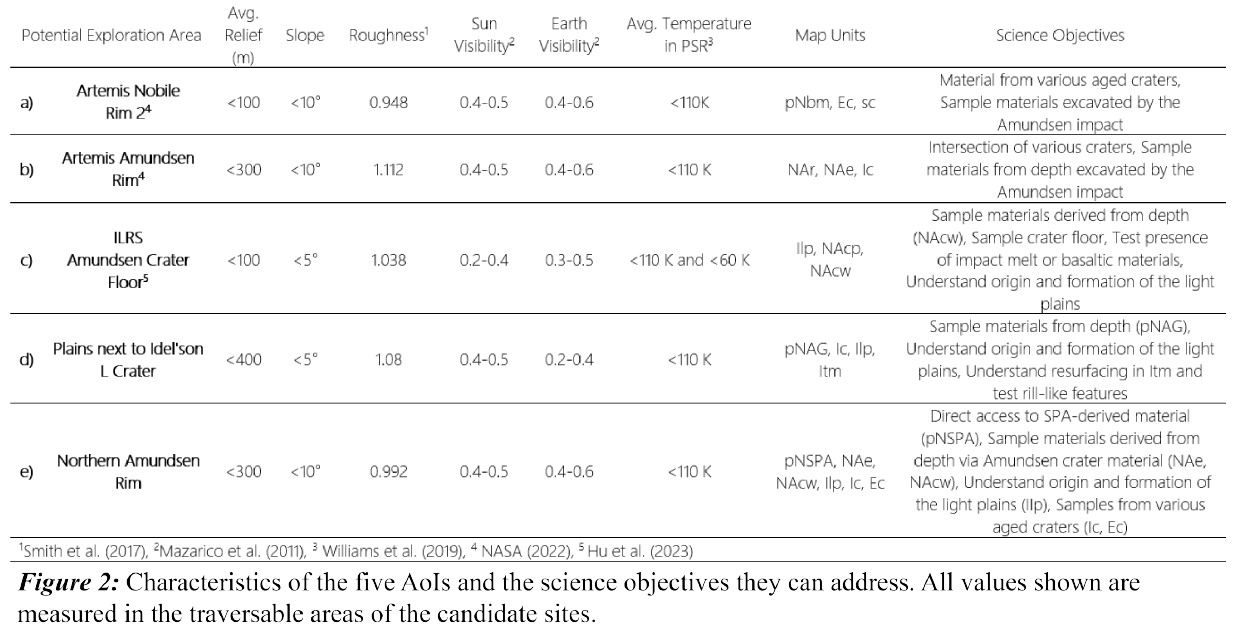- Universität Münster, Institut für Planetologie, Germany (lwueller@uni-muenster.de)
Introduction: The proposed landing and exploration site, Amundsen crater, has been suggested several times [e.g., 1-3]. This is due to its location, size, and diverse geology that records a wide range of the south polar impact history [3-4]. Sunlit regions, regions with high Earth visibility, and the flat crater floor (Figure 1) enhance Amundsen crater’s capability for landing and operations as well as its ability to assess multiple science objectives [5]. This places Amundsen crater as an appealing target for future exploration. To address the local geology and history of the region, we performed 1:100,000 scale mapping of Amundsen crater [3-4]. Following, we identified five potential landing and exploration sites (Figure 1) that satisfy technical criteria, including shallow slopes, sufficient solar illumination, and Earth visibility. These sites also provide sample materials and can contribute to several scientific objectives (Figure 2).
Regional Setting of Amundsen Crater: Amundsen crater, centered at 84.5°S, 85.6°E, is situated in the South Pole-Aitken basin (SPA) near the lunar South Pole. With a diameter of ~100 km, Amundsen crater is the southernmost crater of its size on the Moon and, with its late Nectarian age [3], the youngest south polar complex crater of its size. Amundsen crater is located near the outer rim domain of the SPA basin [5], suggesting that ancient lunar rocks exposed by the SPA impact may have been reworked and redistributed by the Amundsen impact [3]. Therefore, sampling and analyzing the Amundsen crater materials and the younger crater materials that have strongly modified the surface will allow us to explore a wide range of south polar impact history and the processes that have reworked the crater materials over time.
Areas of Interest (AoI): The Artemis program selected two candidate sites in the Amundsen region, "Nobile Rim 2" (AoI a) and "Amundsen Rim" (AoI b), while the Chinese ILRS potentially targets the Amundsen crater floor (AoI c, [1]). Additionally, we examined two AoIs, that fulfill scientific objectives beyond the aforementioned sites, on the plains near Idel'son L crater (AoI d) and the Rubin crater region on the Amundsen rim (AoI e). Based on traversability constraints, we present an assessment of their ability to address key science objectives.

AoI a Artemis Nobile Rim 2: The Artemis candidate site “Nobile Rim 2” is located in the intercrater highland [3-4]. Most of the region has slopes of less than 5°, low surface roughness, and adequate Sun and Earth visibility (Figure 2). The region is dominated by Eratosthenian crater materials [3], where a km2-sized permanently shadowed region (PSR) are present. Furthermore, the region offers the opportunity to sample undifferentiated pre-Nectarian basin material, potentially containing Nobile ejecta and SPA-derived material redistributed via younger craters.
AoI b Artemis Amundsen Rim: Landing on the Amundsen rim benefits from advantageous Sun and Earth visibility. Shallow slopes exist, but are limited to the flat-topped rim segment, which is surrounded by steep slopes. Consequently, traversability is limited to the flat rim segment, where temperatures vary from 130 K in winter to 240 K in lunar summer [6]. The exploration site is located at the intersection of multiple craters and is capable of sampling materials excavated from depth by the Amundsen impact [3].
AoI c Amundsen Crater Floor: The Amundsen crater floor has been previously proposed as an exploration site [1-2]. Extensive areas with shallow slopes facilitate access to the floor, including the large PSR, and promote traversability and mobility. Sun and Earth visibility [7] allow for solar power generation and direct communication with Earth in a favorable temperature regime [6]. The central peak represents the deepest derived materials that can be sampled, while materials on the crater floor can be studied to determine their nature and origin. This will offer valuable insights into the origin, distribution, and thickness of plains found elsewhere. The Amundsen crater floor provides one of the largest and coldest PSRs at the South Pole, where potential CO2 ice can be sampled [8].
AoI d Plains near Idel’son L Crater: This site exemplifies the most diverse geology and offers favorable landing conditions (Figure 2). Investigating the terra-mantling unit [3] at this site will help to address the nature and timing of a potential resurfacing event [3]. In addition, volatile studies can be conducted in the PSRs.
AoI e Rubin Crater Region: The northern rim of Amundsen crater, where Rubin crater is located, benefits from favorable landing conditions with a wide range of scientific objectives (Figure 2). The selected region is primarily characterized by its location on a massif that is considered to be the SPA rim [3]. The candidate site is covered by Amundsen ejecta, but features younger craters such as the Eratosthenian Rubin crater [3]. The Rubin crater is of particular interest as it may have reached the underlying massif and excavated SPA-derived material.

Conclusion and Outlook: Based on our map, we have identified five AoIs that meet landing safety requirements and are capable of addressing key science objectives. We are not prioritizing one AoI over another, as the final selection will depend heavily on the design, scope, and duration of a mission. As a continuation of this study, we are producing higher resolution geological maps for each AoI to further refine site selection for different types of landed missions, setting the stage for maximum scientific return from the Amundsen crater region.
References: [1] Hu et al. (2023) P&SS 227. [2] Lemelin et al. (2014) P&SS 101. [3] Wueller et al. (2024) PSJ, accepted. [4] Wueller et al. (2024) LPSC 55, Abstract#1015. [5] Artemis SDT report. (2020). [6] Williams et al. (2019) JGR 124. [7] Mazarico et al. (2011) Icarus 211. [8] Schorghofer et al. (2021) PSJ 1.
How to cite: Wueller, L., Iqbal, W., Frueh, T., van der Bogert, C. H., and Hiesinger, H.: Comparison of Landing Conditions and Science Potential of Candidate Landing Sites at Amundsen Crater near the Lunar South Pole, Europlanet Science Congress 2024, Berlin, Germany, 8–13 Sep 2024, EPSC2024-473, https://doi.org/10.5194/epsc2024-473, 2024.